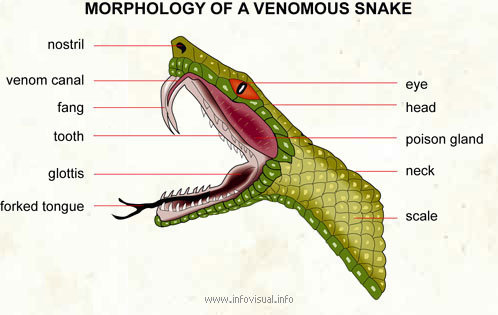Snake

Eye: organ of sight of a snake.
Head: foremost part of a snake.
Poison gland. venom-producing gland of a snake.
Neck: part of a snake between the head and the body.
Scale: each of the hard plates covering the body.
Forked tongue: forked organ in the mouth of a snake.
Glottis: opening in the larynx of a snake.
Tooth: organ used to crush food.
Fang: hard organ used to inject the venom of venomous snakes.
Venom canal: tube that carries the venom.
Nostril: nasal opening.
Photo :
EN : Yellow
anaconda (Aquatic boa)
FR : Anaconda
ES : Eunectes

Eunectes notaeus is a non-venomous boa species found in South America. No subspecies are currently recognized. Anaconda in the wild spend most of their time in rivers hunting for their food. They are solitary creatures that are thought to be somewhat shy and not many of them are easily seen. Adults are not as large as the green anaconda, E. murinus, but nevertheless grow to an average of 305-366 cm (10-12 feet) in length. The maximum size is almost certainly larger. Females are larger than males. The color pattern consists of a yellow, golden-tan or greenish-yellow ground color overlaid with a series of black or dark brown saddles, blotches, spots and streaks.
Animation : Deadly Venomous Viper
Thanks to YouTube for allowing us to watch this video.
Objet virtuel : Deadly Venomous Viper
Thanks to YouTube for allowing us to watch this video.